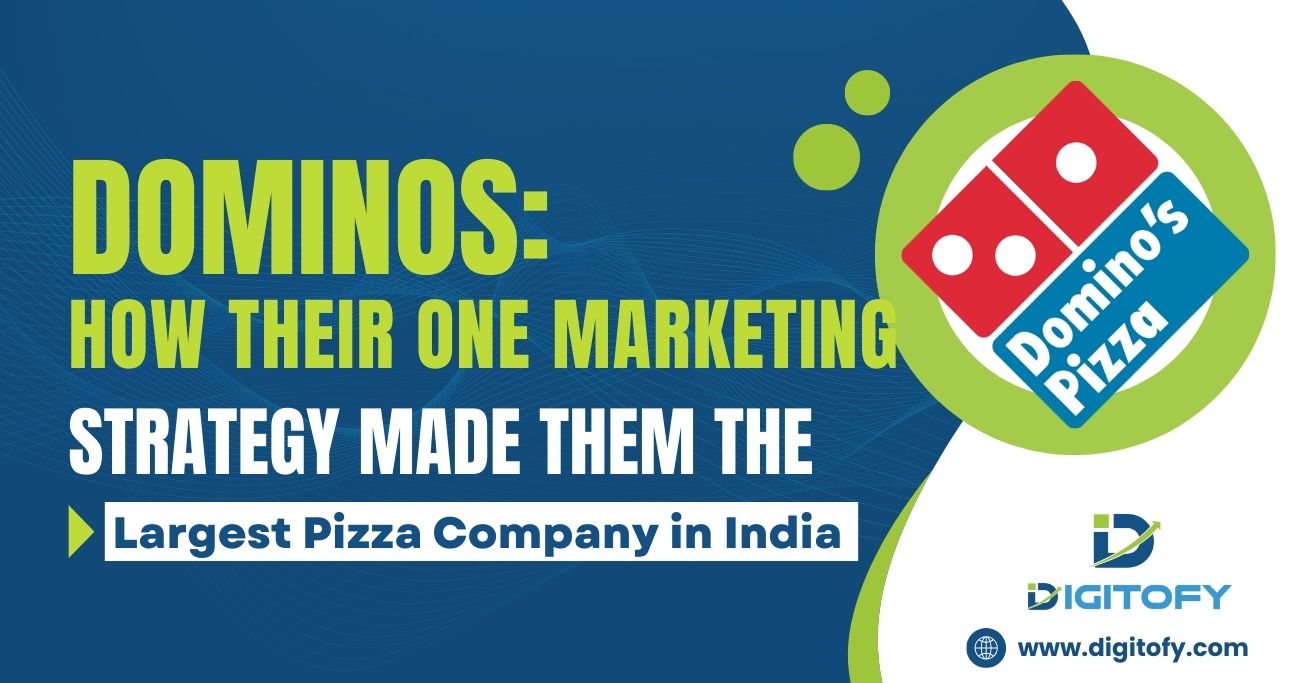Fueling Rapid Growth: Domino’s Clever Marketing Strategy in India
India represents a key growth market for many international food brands due to the country’s massive population size and developing economy. American pizza franchise Domino’s has utilized smart marketing tactics and consistent innovation to carve out a leading position in the Indian market.
This blog post will analyze Domino’s key buyer demographics, marketing mix strategies, approaches to differentiation versus local competitors, and some of the creative tactics fueling the brand’s impressive expansion across India.
Also, Watch Our YouTube Shorts Video on Day 68 – How Chayoos Captured Gen Z’s Gen Y’s Audience with This Simple Marketing Strategy
Know the Brand – Dominos India
Domino’s first entered India in 1996 through a franchise partnership with Mumbai-based Jubilant FoodWorks. The original plan consisted of 20 store launches over 10 years focused on India’s biggest metro regions.
Domino’s India is now headquartered in Mumbai with over 1,500 locations nationwide as of 2022. The brand operates company-owned stores along with a franchise model, pairing local business partners strategically based on geography. This allows Domino’s to leverage local connections and expertise to fuel rapid expansion.
Domino’s core menu in India resembles offerings in Western markets, focused around a variety of fresh pizza options that can be customized with different toppings and crust types. The brand also serves pasta, sandwiches, desserts, and beverages as secondary categories.
Recent developments show Domino’s further localizing its menu specifically to appeal to Indian taste preferences. New product launches feature locally-inspired ingredients like paneer, chicken tikka, and peri peri chicken toppings. The brand also caters heavily towards vegetarians given dietary restrictions across much of India.
Related Blog: Also Know about Haldiram’s Iconic Marketing Strategy of their collaboration with Bollywood.
Key Buyer Personas
Domino’s intentionally targeted younger Indian consumers to establish its brand as trendy and modern. The pizza category itself represented a shift towards Western values and expanding social perspectives beyond traditional Indian cuisine norms.
Core buyer demographics consist of upper-middle class Indians under the age of 35 concentrated mostly in affluent urban regions. Pizza functions more as an affordable luxury or indulgent snack rather than sustainance food. Customers demonstrating high acceptance of globalization make up the ideal demographic base.
Psychographic profiling indicates Domino’s customers in India share common values related to novelty seeking behaviors and early adoption mentality. They actively try new products first, embracing parts of Western culture while retaining ethnic traditions. Many perceive pizza as a fun chance to “break rules” set by previous generations and rigid societal standards.
Customer needs center heavily on convenience, flexibility in ordering/delivery, and modern digital experiences. Domino’s excels at positioning its brand to align with young Indian consumers shifting away from staunch cultural norms around food. Affordable pricing also matches wallet limitations across their target buyer income brackets.
Also Read: Cafe Coffee Day [CCD] Local, Vocal and Collaborative Marketing Strategies
Marketing Mix Strategies
Examining how each pillar of Domino’s marketing mix caters towards buyer personas yields valuable insights into their positioning approach:
- Product – Domino’s made its pizzas more locally-relevant by incorporating flavors/toppings tailored to Indian tastes. Options like paneer or chicken tikka pizzas appeal broadly. They also focused on extensive vegetarian offerings to satisfy dietary restrictions.
- Price – Tactical price slashing and discounts drive strong sales growth. Domino’s positions itself as an affordable indulgence, with deals as low as INR 99 ($1.25 USD). High order values are not critical.
- Place – With 80% of stores in tier 1 metro regions, Domino’s targets areas with highest concentrations of target urban youth demographics. Also offers ordering flexibility between brick-and-mortar locations, website, and mobile app.
- Promotions – Fun, vibrant messaging portrays Domino’s as exciting and trendy. The brand aligns with major cultural events and occasions celebrated by younger generations like sporting matches or holidays.
Localization sits at the core of Domino’s strategy. Customizing menus, prices, retail expansion strategies and messaging to Indian market conditions allows the brand to gain relevance with buyers.
Similar Post: Frooti’s Unstoppable Marketing Strategy That Made Parle Biggest Beverage Leader In 2000’S
Competitor Analysis
Domino’s Pizza leads India’s still-emerging pizza category by a massive margin in terms of market share. Its closest competitor is homegrown brand Pizza Hut, though the gap is sizeable. Domino’s controls over 70% of market volume, with Pizza Hut trailing at 16%.
Other international QSR brands like McDonald’s or KFC along with domestic chains make up the rest of competition. Most rivals differentiate by prioritizing dine-in experiences or broader menu variety compared to Domino’s singular pizza focus.
When examining attributes most impacting buyer decisions, Domino’s emerges as a standout on the following core differentiators:
- Delivery infrastructure – unmatched capabilities to reliably deliver orders quickly, enabled by hub-and-spoke supply chain model
- Localization – highly tailored menus, flavors, and pricing strategies molded specifically to Indian taste preferences
- Digital innovation – user-friendly website and app that make ordering seamlessly easy
These strengths directly connect back to the convenience, flexibility, and modern experience elements prioritized by young Indian consumers.
Also, Read: MS Dhoni And Dream11: Unravellig The Marketing Strategy Of Top Fantasy App Of India
Unique Marketing Approaches
Beyond traditional marketing mix strategies, Domino’s utilizes other innovative tactics to attract India’s valuable Gen Z and millennial demographics. Two clear examples stand out.
1. 30 Minute Delivery Guarantee
Early on, Domino’s made a daring promise to deliver pizzas within 30 minutes of orders placed. This commitment addressed buyer needs for convenience while differentiating significantly from competitors.
Domino’s built capabilities specifically to uphold this promise, optimizing supply chains and store locations to meet quick service standards. They gamed the system strategically with smaller-sized pizzas requiring less time in ovens. Landing this guarantee shaped positive brand perceptions.
2. Value Platforms
Domino’s promotes regular deals across its menu items to showcase affordability. Examples include:
- All pizzas available for INR 99 ($1.25 USD) during weekdays
- 2 pizzas for INR 249 ($3 USD) on weekends
- “Buy 1 Get 1” offers
These value promotions cater to budget constraints of India’s middle class. It propels Domino’s lead in market share based on volume growth.
Tactics like these enabled Domino’s to carve out strong mindshare that still persists given how priorities of time, convenience, and value align with young Indian consumers getting their first taste of western fast food concepts.
Also Read: How Peyush Bansal’s Marketing Strategies Made Lenskart The Most Lovable Brand?
Conclusion & Key Takeaways
Domino’s clear recipe for success in India shows how customize mission-critical elements of a brand’s strategy to resonate in unique cultural contexts. Localization sits at the core along with constant menu innovation.
Key lessons for other international food brands eyeing India include:
- Reject one-size-fits-all approach and deeply understand local preferences
- Prioritize delivery infrastructure and support claims through supply chain mastery
- Lead disruption by positioning brand as modern, trendy and aligned with youth
- React quickly to feedback, adjustments will be ongoing
Domino’s dominated the pizza category by selling not just great-tasting affordable pizza, but the full experience of indulging in foods representing changing social norms. Local competitors and global brands alike still struggle matching service capabilities and genuine cultural embeddedness.
India still presents massive runway for growth in the food services industry. But unlocking full potential requires strategic embrace of the country’s diversity, youthful demographics, and modernizing behaviors.
Related Blogs:
- How DS Group Made History by Selling 100 Crore Pulse Candies in 8 Months
- How Country Delight Influencer Marketing Strategy Took Them to 500+ Crores
- How Chayoos Captured Gen Z’s Gen Y’s Audience with This Simple Marketing Strategy
- Disrupting the Hotel Industry: How OYO Rooms Took Marketing by Storm
- Redbus: Dominating Indian Online Bus Booking Industry with this Digital Marketing Strategy

.webp)

